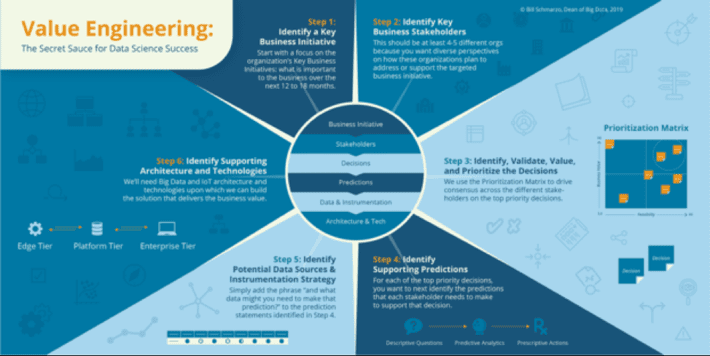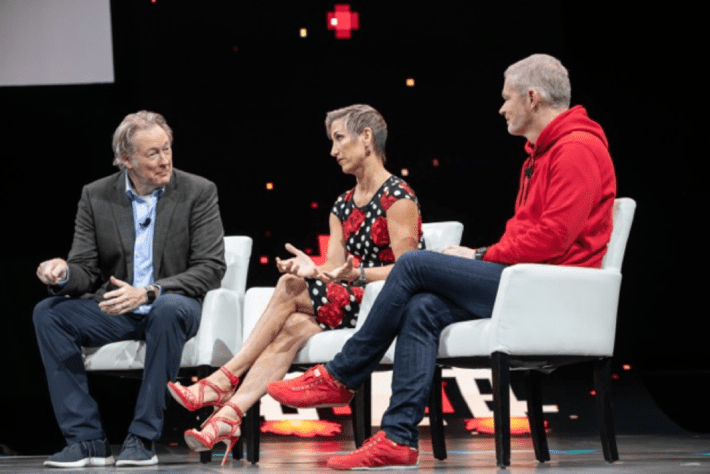Data is a unique economic asset; it never depletes, never wears out and can be used across an unlimited number of use cases at near zero marginal cost. Data in the hands of management and operational leadership can be used to drive material, financial, operational and customer impact. And maybe the best part of this winning data equation? You already own the data! But unfortunately, data is the Rodney Dangerfield of corporate assets – it gets no respect!
To exploit the economic potential of data to derive and drive new sources of customer, product and operational value dictates that the CIO MUST assume a leadership position to make that happen. The modern CIO must move beyond just data management and governance and embrace an approach that leads the IT organization to collaborate with their business counterparts to identify where and how data and analytics can create value across the organization. That is the heart of Value Engineering. And this is the profit-centric framework that Hitachi Vantara’s industry-leading CIO, Renée Lahti, has embraced (see Figure 1).

Figure 1: Value Engineering Framework
What differentiates Renée Lahti from other CIO’s is her aspirational vision to transform Corporate IT from a reactive organization that is whip-sawed by the whims of the business functions into a profit center that contributes to both the top line (Sales) and bottom line (profits) of the organization. Renée expects her IT leadership team to embrace a proactive role in helping the Business Functions to identify where and how these business functions can embrace data and analytics to drive measurable and material business, operational and customer outcomes.
Renée, along with our Chief Marketing Officer Jonathan Martin, became our internal guinea pigs for our Value Enablement process (we called the engagement “Project Champagne” because we felt it was very important that all technology companies drink their own champagne, which is a much better visual than eating one’s own dog food). There is much that the IT world can learn from Renée, and I am going to use this blog to share her aspirations and how she is making this happen today.

Bill Schmarzo interviewing Renée Lahti (CIO) and Jonathan Martin (CMO) at Hitachi Vantara NEXT
Project Champagne: Drinking Our Own Champagne
“If you want to change your game, change your frame” – Bill Schmarzo
Okay, I realize that quoting oneself in your own blogs is sort of weird but I’m attempting to drive a point home here.
I took the opportunity to interview Renée for this blog. I hope you enjoy her fresh and provocative view on the role of the modern CIO.
Question #1: What is your Aspirational Vision in transforming IT from a reactive organization that is whip-sawed by the business functions, into a leadership role to identify where and how the business functions can embrace data and analytics to drive business outcomes?
Answer: I have used the phrase IT needs to Commercialize itself in order to stay relevant and drive measurable and material business outcomes. Specifically, for Hitachi Vantara – and the broader ecosystem of Hitachi sister companies – IT needs to operate like a Commercial-Industrial organization…like a Data Monetization factory. IT will always be responsible directly or indirectly (insourced or outsourced) for the table stakes of keeping the infrastructure and applications running and the IT lights on, but the importance of the keeping the lights on is so the Data Factory can operation.
Question #2: Everyone was telling you the Data Lake was the answer, but what did you quickly learn about the Data Lake?
Answer: The Data Lake is a buzz word. It was a trendy over-simplification of a technology as a solution to a “very wicked” (Urban Planning term) problem. In other words, there was no simple technology answer to the data monetization challenge. A “wicked problem” is a problem that has no determinable stopping point. So how is it that a Data Lake technology solution can solve such a challenge? Common sense says that building such a technology architecture and then dumping IT and OT data into it cannot possibly solve societal challenges – magically – fact patterns are not going to just show up and monetize themselves by co-locating all data. Duh.
Question #3: How did you “change your frame” to take a different approach with your Data Lake?
Answer: I am a design thinker advocate, especially the component of “reframing.” After having built and tested the Hitachi Vantara Data Lake (which was important to do as part of IT’s commitment to “Eating Our Own Cooking”, and this Data Lake was our own, Lumada product). However, if I looked at how we constructed this Data Lake, I realized we fell into the trap similar to others, building technology without strong commitment for business value. Simply put, I asked “why” does Hitachi Vantara need a Data Lake? This simple why reframed the problem and very much expanded the landscape of solutions. In my case, asking why do we need a Data Lake allowed for a productive but disruptive business model to show up . . . Digital Value Enablement – the construction of an organizational support model across business stakeholders to identify, validate, value, prioritize, prove out and operational use cases that support organization’s key business initiatives. This is done through the use of a Data Monetization Factory . . . not a Data Lake. And IT moves from a cost center to a profit center by linking DataOps + Data Science + DevOps to develop and operationalization analytics that power a company’s key business initiatives. In the case of Hitachi Vantara, that means IT and the Lines of Business need to be working together, with common language to systematically focus on an outcome (not a technology solution).
Establishing this common language doesn’t just stop by breaking down silos within the Hitachi Vantara organization. Hitachi Vantara is part of Hitachi Ltd, an MNC of 900+ sister companies. This DVE discipline and Data Monetization Factory can be applied across all of Hitachi Ltd. Which makes the economic value of data even more powerful and reusable for those focused on outcomes for a healthy bottom line AND for society benefit.
Question #4: And the results?
Answer: The results are that our Enterprise Data Platform (EDP) Data Lake became one of many vessels that store data in a Virtual Data Lake construct (edge-core-cloud) that helped Hitachi Vantara organize to define and prioritize business use cases for the Chief Marketing Officer (first of many executive friendlies who I would be working with) where predictive analytics could unlock incremental business and operational value, and then prove that value. At a high level, this is how the story went:
- At the beginning Hitachi Vantara completed a Digital Envisioning Workshop where we prioritized theCustomer Upsell business use case as the targeted pursuit.
- Further refining the outcome through the DVE and data science teams, the Proof of Value phase built predictive models that will predict an existing customer’s propensity to buy a specific newly launched Hitachi Vantara solution (theVSP 5000 series aka Jupiter).
- The result: The primary outcome of the Project Champagne Up-Sell Recommendation Model was to score and prioritize existing global customers based on their operational needs to create a “propensity to buy” score for the VSP 5000 series. AND the creation of reusable data and analytic assets for re-use across aninfinite number of future use cases.
Question #5: What advice do you have to the CIO’s and Chief Data Officers out there?
To all CIDOs (Chief Innovation and Data Officers), I am assuming all are already exploring the digital data-intensive use cases to solve your company’s or industry’s problems. The guidance I would give is a reminder that organizations that can effectively govern the broad development/deployment of data assets will be able to launch/scale advance 3x faster than competitors (per IDC). That means embracing a single strategy and architecture for data: Edge-Core-Cloud. And that means don’t be shy, be tenacious about making the required organizational and cultural changes to support this Data Strategy in this Digital Economy (no matter the ups and downs, (e.g. like a recession).
Words of wisdom and experience. Thank you, Renée!
And, I must admit, I love working with Renée because she brings a fresh, get’er done, business-centric perspective to the world of IT. Very much looking forward to our continued adventures together!
